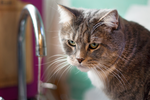
Keeping Pets Hydrated: Why Hydration Matters and How to Make It Easy
, by Majella Gee, 6 min reading time

, by Majella Gee, 6 min reading time
Keeping Pets Hydrated: Why Hydration Matters and How to Make It Easy
As summer approaches in Australia, the importance of keeping your pets hydrated becomes even more critical. Just like us, animals rely on water to regulate their body temperature, digest food, and keep their organs functioning. Dehydration can be a life-threatening issue, especially in the sweltering summer months when temperatures soar, and pets are more active. Whether you have a cat or dog, keeping them hydrated is non-negotiable.
Let’s dive into why hydration is so important, how to encourage your pets to drink more, and some essential tips for keeping your pets safe this summer.
Why Hydration is Critical for Your Pets
Water is the foundation of life, and our pets are no exception. Every system in their body needs water to function properly—from digestion to circulation, to temperature regulation. When an animal becomes dehydrated, their health declines rapidly. Thickened blood makes it harder for their heart to pump, straining their kidneys and liver, and ultimately, their organs begin to shut down.
Dogs are typically better at hydrating themselves, but they’re still at risk, especially when active in hot weather. Cats, on the other hand, are often poor drinkers, and this can lead to serious health issues, including Feline Lower Urinary Tract Disease (FLUTD). This condition is particularly common in male, desexed cats. My mum’s cat suffered from this condition and tragically passed because we didn’t catch it early enough. Years later, I had another cat with the same issue. Thankfully, I caught it in time, but it required an expensive surgery and months of recovery. FLUTD is common, especially in cats who eat a diet consisting mostly of dry kibble.
Signs of Dehydration and First Aid for Pets
It’s essential to recognize the signs of dehydration before it becomes severe. Look out for:
If your pet shows signs of dehydration:
Encouraging Your Pets to Drink More Water
Some pets need a little encouragement to drink, particularly in hot weather. Here are a few tricks to help:
Heat and Pets: The Deadly Danger of Leaving Pets in Vehicles
Never leave your pets unattended in a vehicle— not even for a minute. On a warm day, the temperature inside a car can rise by up to 20°C in just 10 minutes. By the time you "just pop into the shop," your pet could be on the brink of heatstroke. Temperatures inside a car can quickly reach over 50°C even on a mild day, and in this heat, your pet's body temperature will rise to dangerous levels.
Let me break down what happens during heatstroke:
For a human comparison, imagine being trapped in a sauna, but you can’t sweat to cool down. You’re unable to open the door, and as your body temperature rises, your organs begin to fail. That’s exactly what happens to pets in hot cars, except they have even fewer ways to cool down. Never leave a pet in a car unattended. I’ve personally had to rescue countless dogs from hot vehicles, and the owners always say, “I was only gone for a minute.” One minute turns into ten, and it’s often too late.
Breeds at Higher Risk
Certain breeds and age groups are more susceptible to dehydration and heatstroke:
Hydration for Wildlife
As we take care of our pets, don’t forget about the wildlife. Leaving shallow water dishes out in your garden can make a huge difference for local birds, bees, and other wildlife. Add some pebbles or sticks to give insects a landing spot, helping them stay hydrated without drowning.
Conclusion: Keeping Pets and Wildlife Hydrated All Summer
Hydration is essential for your pets’ health, especially as the heat rises. Whether you’re at home, at the park, or traveling, there are plenty of ways to ensure your pets stay hydrated and happy. From fun water fountains to portable hydration stations, staying hydrated has never been easier. Let’s make this summer a safe and enjoyable one for all our furry friends.
Author: Majella Gee
Model: Arthur
#PetHydration #PetHealth #FLUTD #HealthyPets #PetHealthTips #PetWellness #ThirstyPets #HydrateYourPet #HydrationForPets #PetWaterTips #HydrationIsKey #PetCareEssentials